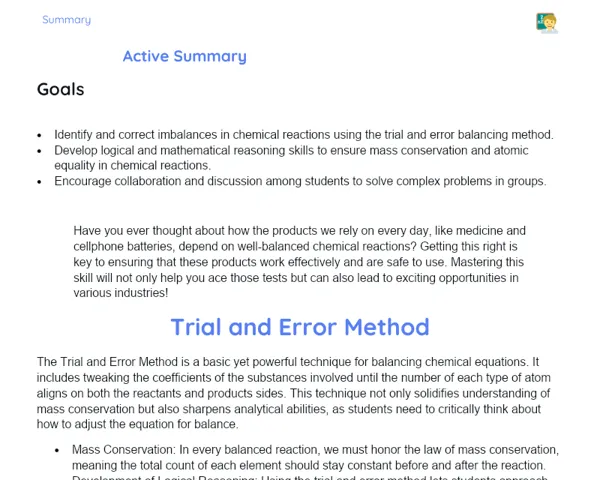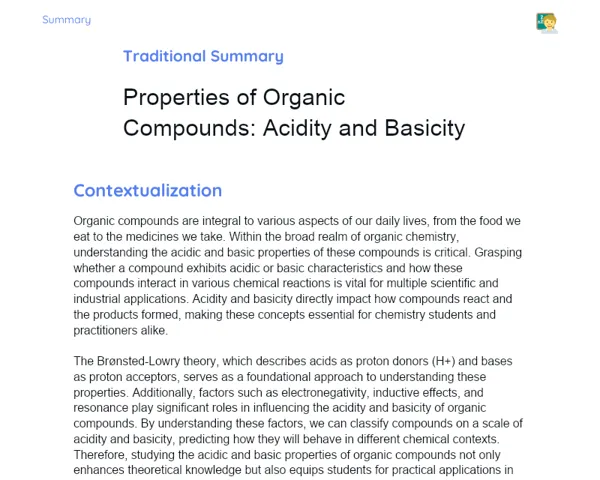Summary Tradisional | Main Reaction Types
Contextualization
Chemical reactions are integrated into nearly every aspect of our daily lives, from industrial processes to the small things we do around the house. Take, for example, how a car operates: the combustion of fuel in the engine is a vital chemical reaction that produces the energy necessary for it to move. Within our bodies, chemical reactions play a key role in essential processes like digestion, where enzymes and acids break down food into nutrients for our bodies to absorb.
In the industrial sector, chemical reactions are crucial for producing a wide variety of goods, from medications and plastics to food products and fuels. Even in our kitchens, familiar tasks like cooking involve numerous chemical reactions. When we bake a cake, for instance, the reaction between baking soda and acids in the batter releases carbon dioxide, which makes the cake rise. These everyday applications highlight the significance of chemical reactions, underscoring the need to study their different types, such as addition, decomposition, single exchange, and double exchange.
To Remember!
Addition Reactions
Addition reactions, sometimes referred to as synthesis reactions, occur when two or more reactants combine to create a single product. This type of reaction is essential in various industrial and biological processes. A practical example is when vegetable oils are hydrogenated to make margarine; this involves adding hydrogen to unsaturated fatty acids. Another familiar example is the formation of water from hydrogen and oxygen, which is fundamental for life.
During addition reactions, new chemical bonds form between the atoms of the reactants, typically resulting in larger and more complex molecules. In organic chemistry, addition reactions often modify the structure of organic molecules, such as adding halogens to alkenes to form alkyl halides, and these reactions are widely researched and applied in organic synthesis.
Furthermore, addition reactions have important real-world applications. For example, in the pharmaceutical industry, many medications are synthesized using addition steps to build complex molecules from simpler ones. In agriculture, adding nutrients to the soil for better fertility illustrates a direct application of this reaction type.
-
Two or more reactants combine to create a single product.
-
Essential in industrial and biological processes.
-
Characterized by the formation of new chemical bonds between the atoms of the reactants.
Decomposition Reactions
Decomposition reactions involve breaking down a single compound into two or more products. These reactions are vital in numerous industrial and laboratory processes. A classic example is the decomposition of calcium carbonate (CaCO3) into calcium oxide (CaO) and carbon dioxide (CO2), which is important in cement production. Another prevalent example is the electrolysis of water, which breaks down water (H2O) into hydrogen (H2) and oxygen (O2), and is utilized in producing hydrogen fuels.
Different energy forms, such as heat, light, or electricity, can trigger decomposition reactions. In thermal decomposition, heat breaks down compounds, while photodecomposition uses light. Electrolysis employs an electric current to decompose substances. These methods are widely used in laboratories and industries to derive specific products from complex compounds.
Beyond industrial applications, decomposition reactions are significant biologically. For instance, the decomposition of organic matter in soil by microorganisms releases essential nutrients that are recycled in the ecosystem. Such reactions are crucial for sustaining life and the balance of natural systems.
-
A single compound breaks down into two or more products.
-
Can be initiated by heat, light, or electricity.
-
Crucial in both industrial and biological processes.
Single Exchange Reactions
Single exchange reactions, or displacement reactions, occur when an element reacts with a compound, resulting in the replacement of one of the components of the compound. For example, when zinc (Zn) reacts with hydrochloric acid (HCl), it forms zinc chloride (ZnCl2) and hydrogen gas (H2). Such reactions are fundamental in metal purification and extraction processes.
These reactions follow a basic rule: the more reactive element displaces the less reactive one in a compound. This is commonly seen in reactions involving metals and acids, where the more reactive metal replaces hydrogen from the acid, releasing hydrogen gas. This reactivity can often be predicted using the reactivity series of metals, which ranks them based on their tendency to lose electrons.
In industry, single exchange reactions are applied in galvanization, where zinc coats iron to prevent rust. They also play a role in energy production, like in fuel cells, where hydrogen reacts with oxygen to create water and electrical energy.
-
An element reacts with a compound and replaces one of the components.
-
Follows the principle that a more reactive element displaces a less reactive one.
-
Key in metal purification and extraction processes.
Double Exchange Reactions
Double exchange reactions take place when two compounds react and swap components to create two new compounds. A classic example is the reaction between sodium chloride (NaCl) and silver nitrate (AgNO3) to produce sodium nitrate (NaNO3) and silver chloride (AgCl). These reactions are commonly found in aqueous solutions and are essential in many laboratory practices.
Double exchange reactions are distinguished by the swapping of ions between the reactants, often resulting in the formation of a precipitate, gas, or a molecular compound like water. These reactions are frequently used in laboratory tests to identify specific ions, as the formation of a precipitate can signal the presence of certain ions in the reaction mixture.
In addition to laboratory uses, double exchange reactions are significant in the chemical industry for synthesizing various compounds. For example, the production of table salt (NaCl) through the reaction between hydrochloric acid (HCl) and sodium hydroxide (NaOH) illustrates a double exchange reaction. Such reactions are vital for creating chemical products and managing industrial waste.
-
Two compounds react and exchange components.
-
Characterized by the swapping of ions between reactants.
-
Important in laboratory tests and the chemical industry.
Key Terms
-
Addition Reactions: Process where two or more reactants combine to create one product.
-
Decomposition Reactions: Process where a single compound breaks down into two or more products.
-
Single Exchange Reactions: Process in which an element interacts with a compound, replacing one of its components.
-
Double Exchange Reactions: Process where two compounds react and exchange components to form two new compounds.
-
Reactants: Substances that interact during a chemical reaction.
-
Products: Substances formed as a result of a chemical reaction.
Important Conclusions
In this lesson, we explored the primary types of chemical reactions: addition, decomposition, single exchange, and double exchange. Each reaction type has its unique characteristics and plays a significant role in both nature and industry. Addition reactions combine two or more reactants into a single product, while decomposition reactions break down compounds into two or more products.
Single exchange reactions occur when a more reactive element replaces another in a compound, which is crucial for metal purification and extraction. Double exchange reactions involve the exchange of ions between compounds, usually resulting in precipitate formation, and are commonly used in laboratory testing and the chemical industry.
Understanding the different types of chemical reactions is vital, not just for grasping everyday chemical processes but also for practical applications in numerous fields, including pharmaceuticals, agriculture, and industry. Familiarity with these concepts enhances our appreciation of the chemical transformations happening around us and how we can apply this knowledge practically.
Study Tips
-
Review the examples of each chemical reaction type covered in the lesson and look for similar reactions in your everyday life.
-
Practice writing and balancing chemical equations for each reaction type to ensure you grasp the process of forming reactants and products.
-
Explore additional resources, such as educational videos and textbooks, to enrich your understanding of the applications and significance of chemical reactions in various contexts.



